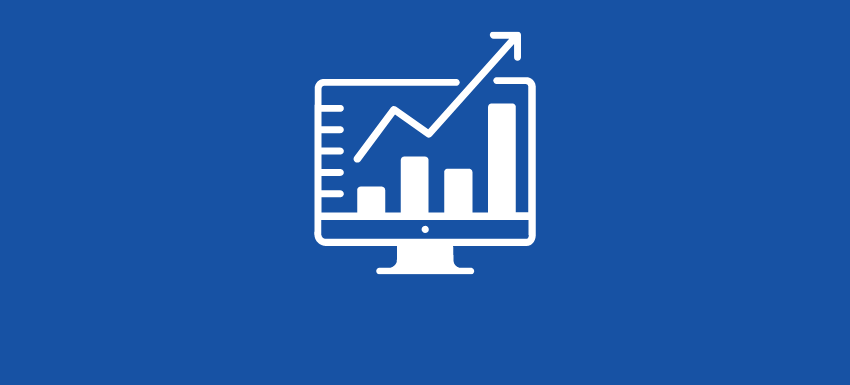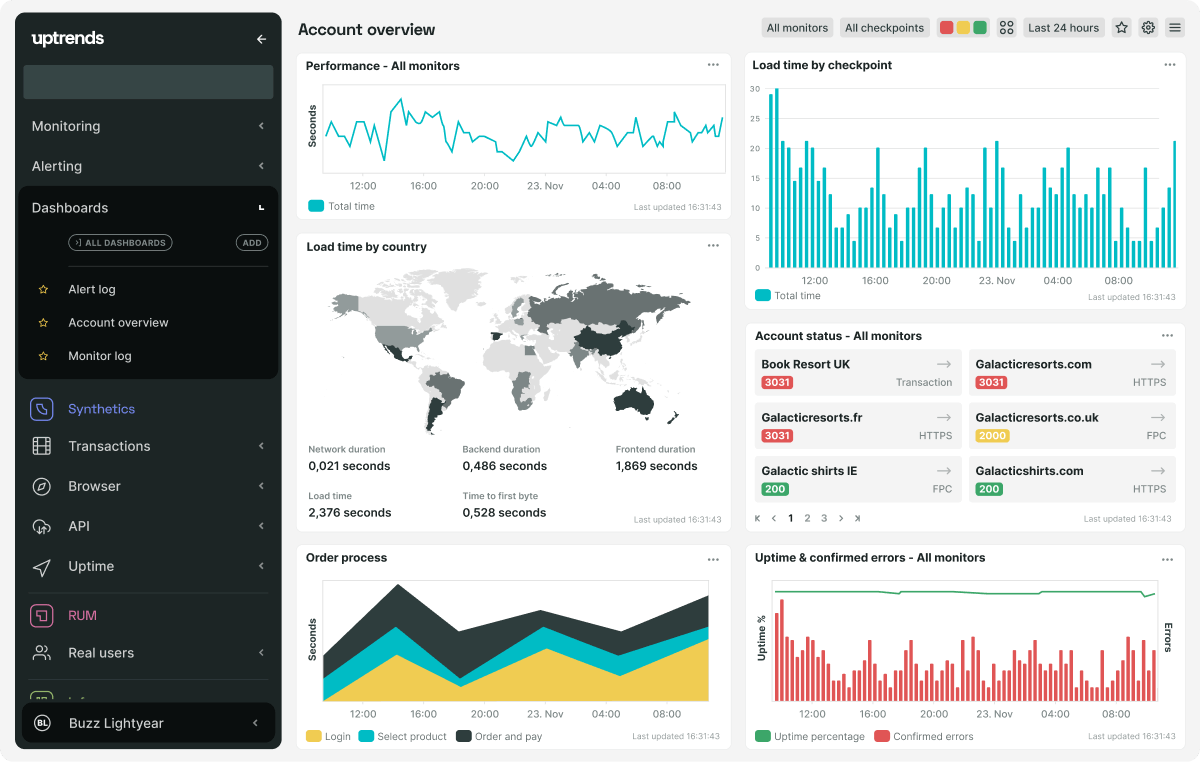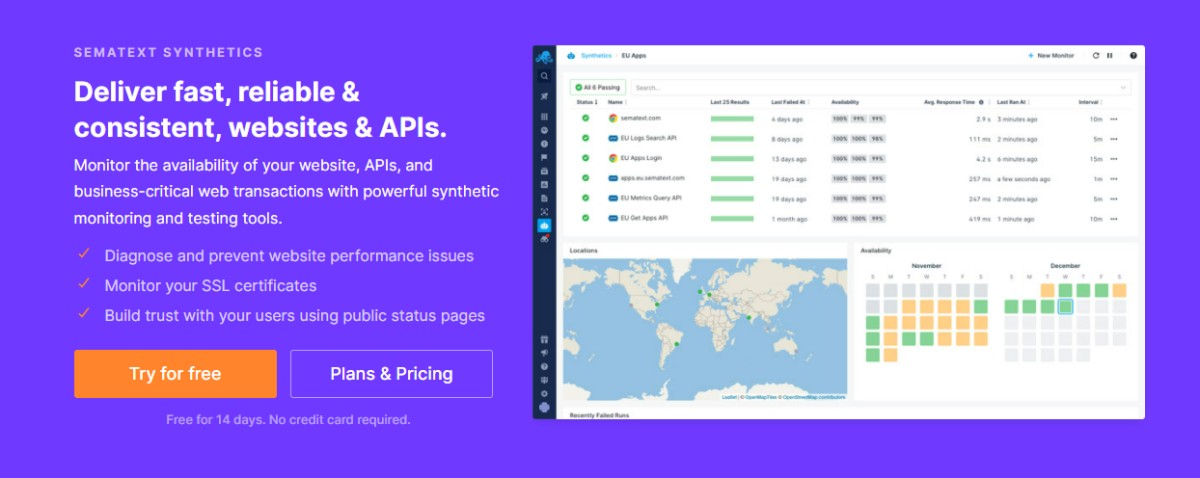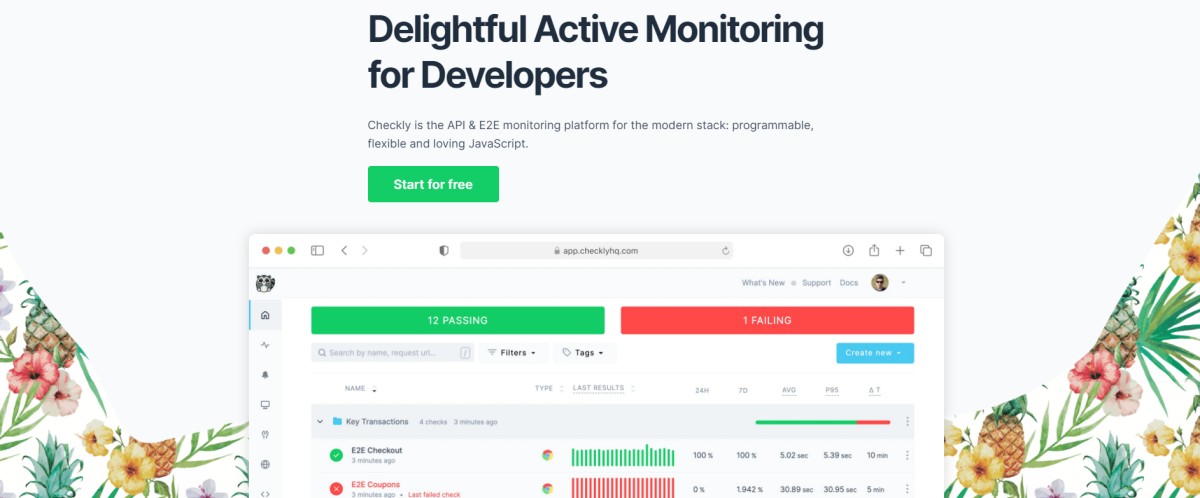Website monitoring is an efficient way to check your website’s performance and issues in real-time. It will help you resolve those issues while ensuring your site functions optimally, loads faster, and is always available to provide an excellent user experience.
The business world is full of competition. You have to think about how the end-users feel while visiting your site to browse products, make a purchase, or read your articles. And there’s no room for a slow loading site with frequent downtimes because it can drive the visitors away.
As a result, your sales, revenue, and profits can be affected. It can also impact your reputation, especially if a visitor is new. If your first impression is poor, they will soon find other avenues.
You can watch your website’s performance, uptime, and functionality by using a website monitoring tool to offer an outstanding user experience.
Let’s discuss website monitoring more and the must-have features of a website monitoring tool.
What is a Website Monitoring tool?
Website monitoring involves the process of monitoring a website and checking its performance, functioning, and availability to ensure an optimal user experience. It is done using various tools and practices by measuring technical parameters and metrics affecting user experience and page loading speeds. And the tools that help you calculate those metrics are website monitoring tools.
These tools can measure metrics like page size, broken links, time-to-first-byte, CPU utilization, database performance, uptime, SSL certificate, domain name expiration dates, SEO, etc. It will help you identify issues affecting your site speed, performance, and uptime. This way, you can resolve the problems faster, restore your website’s function and availability, and provide an unmatched user experience.
There are many providers for website monitoring tools; some are free while others are paid. You can start slow, especially if you have a small team, and gradually move to paid plans to get compressive capabilities to register more success for your business.
Why invest in a website monitoring tool?
Investing in a good website monitoring tool is advantageous in many ways. Here are some:
Enhancing website performance
If you want to improve your site’s performance, you must know how it performs in the first place. Using a website monitoring tool gives you greater visibility into your website performance in all areas. It will help you detect the areas of improvement and places where you shine. You can also find the exact cause for issues, making it easier for you to resolve them. And improving your website performance leads to faster page loading, better SEO, and a great user experience.
User experience
No one has the time for a website with a slow loading speed. If your site takes a lot of time to load or show information, they may get frustrated and find other alternatives. It can drive your revenues away.
This is why offering an excellent user experience is the key to a successful business. Using a good website monitoring tool lets you find all the reasons impacting user experience, like slow page loading speed, frequent downtimes, etc. And when you have the insights into those parameters, you can work on them immediately to resolve the issues.
So, you can offer a consistent, excellent user experience by enhancing load times and site time so customers can read information and make a purchase quickly. It will compound to higher revenue and customer satisfaction rates.
Security
Monitoring your website is also beneficial security-wise. Cyberattackers are everywhere looking for a chance to hack into your website to steal information and harm your business and reputation. And if your site has a slow loading speed, outdated security patches, and expired SSL certificates, it can become highly vulnerable to attacks.
But continuous monitoring gives you all the information regarding site security and expiration dates of your services like SSL certificates. You can also detect security issues and resolve them in real-time before any bad actors can play and harm your site. In addition, you can renew your SSL on time with notifications received from the website monitoring tool you use. All this will help secure your website and data.
Types of Website monitoring
Website monitoring can be divided into:
Uptime Monitoring
Uptime monitoring involves checking a website for its availability. Your site can go offline or face downtimes due to any reason – server issues, cyberattack, or anything else. But it may impact your businesses hugely in terms of user experience, sales, reputation, and ultimately revenue. Hence, you must monitor the uptime of your website, web services, and APIs. It will detect if your servers are up and running.
Performance Monitoring
As the name suggests, performance monitoring checks the performance of your website. It will check the overall performance of individual pages or pieces like scripts, images, timeouts, CSS, etc. It will also give you an idea about your page loading speed, browser load times, connection speeds, and more. Additionally, you can detect web page errors, missing content, and other things affecting site performance.
Functionality Monitoring
Functionality monitoring is used to check your site’s functionality. A website monitoring tool uses scripts interacting with site search, forms, payment systems, shopping carts, etc. It can interact with your website like a regular visitor to check the functionality. Upon detecting any errors, it notifies you so that you can resolve the issue immediately.
Server Monitoring
You can determine how your server performs using a monitoring service if the device or server recognizes IP/TCP protocols. Server monitoring checks the site availability once a minute to prevent downtimes and reduced productivity.
SSL and Domain Monitoring
Some website monitoring tools check your SSL certificates and domains. They ensure the certificates are configured well and notify their expiration dates. Besides, they also check your domain, verify DNS records, query databases, and do many more things at an advanced level.
When you start your hunt for the best website monitoring tool, you will find plenty of options. So, you need to look for some specific features to make the most of a website monitoring tool.
Must-have features of a Website Monitoring Tool
Frequency of checks
A website monitor pings your website to check if everything is okay every few seconds or minutes. It will vary for different monitoring tools. The smaller the interval, the better will be your website monitoring.
If you have a big site or eCommerce store and some big festivities are coming, you may want to monitor your sites at frequent intervals. So, you can choose which interval will be best for you based on your needs.
Geographic Monitoring Locations
While selecting a site monitoring tool, make sure to choose the one that monitors from multiple locations. It is especially evident if you are a global enterprise or publication catering to an audience from across the globe. By monitoring at different locations, you will ensure that your site is running well from other countries and provide the best experience at all the places you serve.
Types of checks
There are different types of website monitoring like uptime monitoring, performance monitoring, domain monitoring, SSL monitoring, SEO monitoring, etc. You need different kinds of checks to ensure your website’s performance, uptime, and functionality are top-notch. Hence, check if the website monitoring tool you choose offers how many types of checks; the more, the merrier!
Notifications
The website monitoring solution must provide real-time notifications on detecting something suspicious or vital. It will ensure you can get instantly notified when something goes wrong so you can perform quick fixing. It’s crucial during security issues because you need to avert any possible breach that may happen at any time.
Also, check for how the tool offers notifications to you. It must provide various channels such as email, SMS, Slack, webhooks, etc., to supply notifications.
Third-party integrations
The website monitoring tool must easily integrate with third-party tools for various purposes like collaboration, SEO, performance, and more. For example, many teams use Slack, which will benefit your entire team if your website monitoring tool can support the integration. It will enable you to communicate to the correct stakeholders on the proper channels.
Reporting and benchmarking
You must have a sound reporting system enabled in the website monitoring tool to track your performance, uptime, functionality, and other website aspects. By looking at the reports, you can understand various issues, the causes, and areas that need improvements. Hence, choose a tool that offers comprehensive reporting.
In addition, you must also measure the performance of your competitors to gain clear visibility into how your performance stacks up against others in the marketplace. It will help you improve your services and find ways to always stay ahead in the game.
Multi-step user flows and business transactions
The website monitoring tool must offer the feature of multi-step user flows and business transactions like logins, checkpoints, shopping carts, etc. The tool must provide excellent scripting capabilities to effortlessly design the flows based on your requirements. It benefits your business and customers and delights your developers by making the task easier for them to dedicate time for more innovation.
Pre-production testing
This allows you to experiment with different “What If” scenarios and view the impact on site performance. It will enable you to create different staging environments and test your website under them to find how your website behaves. You can also customize it based on your use cases to ensure a great user experience. So, the website monitoring tool must also have a pre-production testing feature.
Content rendering checks
Keeping track of not only the page rendering speed is essential, but also its accuracy. It will ensure how your content looks to end-users and optimize it to avoid trouble while reading information from your site.
Web page availability
Apart from determining the entire website availability or uptime, you must also measure the uptime of specific web pages. It will ensure that each web page works just fine with no errors to improve user interaction with those pages. It will also improve the SEO ranking page-wise.
Real browser testing and mobile simulation
To truly emulate end-user experience, web tests must be performed from various browser types and versions. It’s because your users might visit your site from across the world using multiple devices and browsers.
This is why you must ensure your website works optimally no matter what browser or device the user is using. You can also simulate mobile users by platforms like Android, iOS, etc., browsers like Safari, Chrome, etc., or wireless speed like 3G, 4G, or 5G).
SEO and certificates
You must ensure your site’s SEO is excellent to get discovered and gain more traffic. This is why the website monitoring tool you choose must offer SEO monitoring as well. The tool must also check for certificates like SSL so that there are no errors in them and you can know their expiration dates. It will help you renew the certificates on time and ensure your site remains secure.
So, if you want to have the features we discussed above in a website monitoring tool, we have some of the best website tool recommendations for you.
StatusCake
Monitor your website performance using StatusCake and stay online, consistently beat the competition, and drive revenue. Apart from keeping an eye on your site performance, it will notify you regarding any downtime on your website immediately when it happens.
You can rely on StatusCake to do all the hard work while you can spend time expanding your business. It offers excellent uptime monitoring with a check rate of 30 seconds and monitors the site from 30 countries, making it easier to understand your site’s uptime variation.
Never let slow page loading damage your SEO, online presence, and revenue; use StatusCake to get your site load faster and drive your conversion rates. It will also help you with Core Web Vitals and lets you identify why your site is slow, and shows ways to improve page loading speed.
StatusCake will ensure your site’s SSL certificate and domain name are renewed on time by notifying you of expiration dates. Hence, your current SEO and security will remain unaffected, and you will never lose your domain name. In addition, you can monitor your server and get alerted when the RAM, disk space, and CPU usage exceed.
Whether your want to monitor your site, server, SSL, domain, uptime, or page speed, StatusCake will do it seamlessly by letting you collaborate effectively. It doesn’t matter if you have a DevOps team or not; they will provide you with all the tools to make the process easy.
Try a 7-day free plan without revealing your credit card. StatusCake has a free plan suitable for small businesses and individuals with basic monitoring capabilities. You can choose a paid plan based on your requirements by discussing it with StatusCake.
Uptrends
Uptrends is an all-in-one solution that offers website monitoring, API monitoring, and web application monitoring. Downtimes can happen at any time, but you must know when it happens; Uptrends does that so you can provide a consistent customer experience.
More than 30k users trust Uptrends, including Microsoft, NASA, SpaceX, Vimeo, and Zendesk because of its outstanding features. You can set intervals to perform site monitoring up to the minute and combine it with reliable alerting to resolve issues faster and enhance your web performance.
Uptrends Synthetics has 228 checkpoints across its global network, so you can understand your performance and uptime status no matter where you are. You can also monitor multi-step transactions like logins, checkpoints, and shopping carts. Besides, you can either set up the scripts yourself or allow their support team to manage that for you.
Detect the problem source quickly through web performance monitoring via Chrome, IE, and Firefox and get load-time alerts along with comprehensive waterfall reports. You can set up continuous monitoring for your API to find uptime fluctuations and verify API responses by setting up calls.
Uptrends alerts you via phone calls, push messages, SMS, or emails through its mobile apps, or you can create custom integrations in your DevOps tool via webhooks. You can also seamlessly integrate your site monitoring with different tools, like Slack, PagerDuty, or Microsoft Teams.
Moreover, Uptrends RUM measures user experience by collecting metrics like your website’s real user traffic and data from real devices, people, and connections. You can also diagnose uptime and performance issues by understanding the bottlenecks and resolving them quickly by Uptrends Infra.
Start site monitoring free for 30 days with Uptrend and choose a paid plan after it expires.
Sematext
Monitor the uptime of your APIs, site, and business-critical transactions using a robust synthetic monitoring tool – Sematext. It helps you deliver reliable, consistent, and fast services to your customers by letting you understand issues and diagnose them,
Sematext Synthetics offers HTTP monitoring to help you track app and site availability from global checkpoints, private networks, and behind firewalls. You can track timings across different layers, including SSL, HTTP, TCP, and DNS. You can also customize your request, verify API responses, and get alerts through Webhooks, Slack, or emails.
Find the moment your site goes unavailable or your transaction fail or slow down by:
- Measuring page loading performance
- Tracking Core Web Vitals
- Monitoring SLAs and third-party performance
- Diagnosing issues through waterfall analysis
- Simulating user interaction with Chrome browser, and
- Benchmarking website performance against competitors’ transactions and critical pages.
Furthermore, monitor your SSL certificates and their issues and expiration dates. Sematext alerts you when it detects any problems and offers a detailed report. It can also provide end-to-end visibility by monitoring metrics, logs, APIs, site uptime, and user experience.
Freshping
Freshping by Freshworks is another reliable name in site monitoring, used by thousands of businesses across the globe, including Starbucks, cardinal Group, Mercer, and more. It can monitor your site and applications no matter what you are building.
Freshping can perform 50 checks at a minute interval, monitor HTTPS or HTTP URLs, ICMP Ping, web sockets, DNS, UDP, and TCP from 10 worldwide locations, and mitigate false positives. It alerts through SMS or email, and you can also configure webhooks and set up a custom alert channel for your business. You can easily integrate this site monitoring solution with various tools like Twilio and Slack.
Freshping will tell you exactly what issues are responsible for causing downtimes so you can tackle them immediately and restore your services. It helps you increase transparency with your users by informing them quickly about downtimes.
Freshpings offers 5 Public Status Pages that you can use to inform incidents and current status. You can also set custom branding and domain to provide an authentic user experience. It is free for a lifetime.
Checkly
Checkly offers active E2E and API monitoring for the modern tech stack that’s programmable, JavaScript-based, and flexible to delight your developers. It helps you monitor your site transactions and validate them quickly.
You can also automatically collect performance metrics, screenshots, and error traces with each browser check. Coding browser click-follows are no more challenging; Checkly lets you use modern open-source frameworks such as Playwright to quickly automate your flows and run checks from 20 global locations.
Checkly’s intuitive editor allows you to configure robust HTTP requests to ensure your API responses are fast with different payloads. In addition, start your checks using their cURL and Swagger importer. You can also add Node.js-based teardown scripts and clear assertions for comprehensive API monitoring.
Moreover, run synthetic and API monitoring scripts against staging environments to catch bugs and resolve them quickly to enable faster production. Stay updated with alerts via SMS, emails, Slack, webhooks, Opsgenie, and Pagerduty. It can also integrate easily with tools like Terraform, GitHub, JavaScript, and Prometheus.
Conclusion 👇
Using a website monitoring tool can help you improve your site’s uptime, performance, functionality, SEO, and various other aspects. Thus, choose the best monitoring tool based on your needs and look for the discussed features.
You may also be interested in Website Monitoring Tools for Small to Medium Enterprises.
Si quiere puede hacernos una donación por el trabajo que hacemos, lo apreciaremos mucho.
Direcciones de Billetera:
- BTC: 14xsuQRtT3Abek4zgDWZxJXs9VRdwxyPUS
- USDT: TQmV9FyrcpeaZMro3M1yeEHnNjv7xKZDNe
- BNB: 0x2fdb9034507b6d505d351a6f59d877040d0edb0f
- DOGE: D5SZesmFQGYVkE5trYYLF8hNPBgXgYcmrx
También puede seguirnos en nuestras Redes sociales para mantenerse al tanto de los últimos post de la web:
- Telegram
Disclaimer: En Cryptoshitcompra.com no nos hacemos responsables de ninguna inversión de ningún visitante, nosotros simplemente damos información sobre Tokens, juegos NFT y criptomonedas, no recomendamos inversiones













